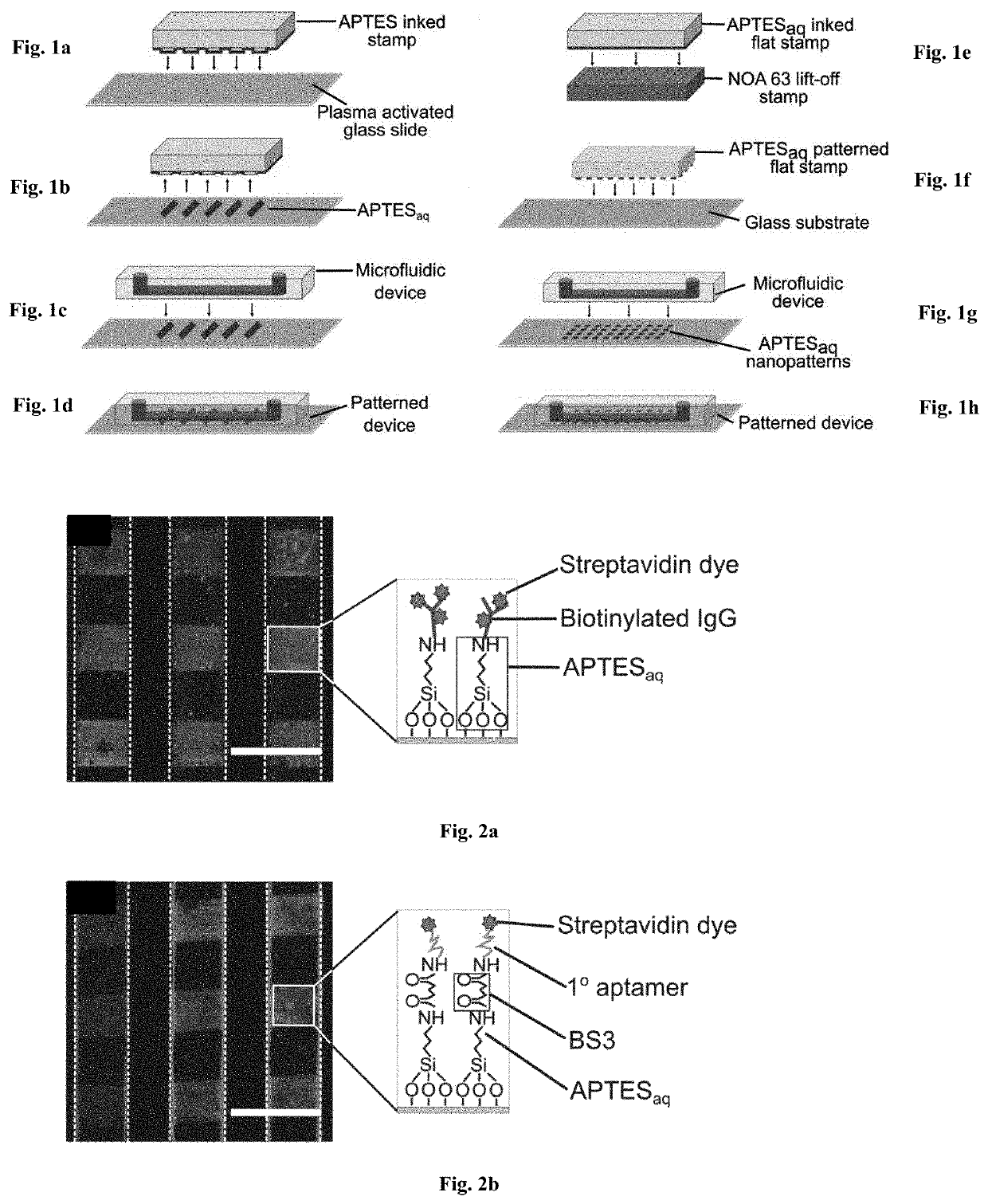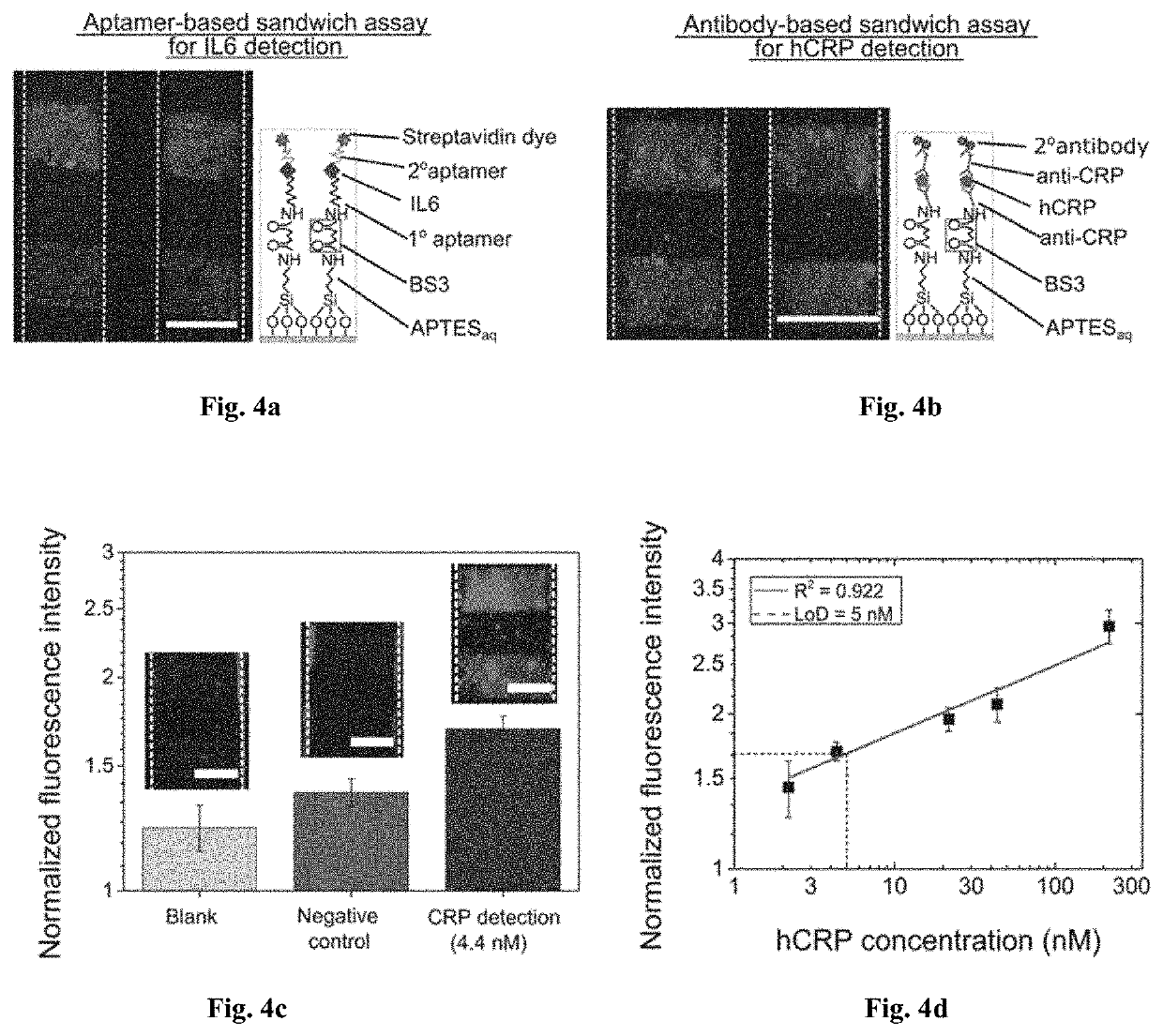Micro- and nanocontact printing with aminosilanes: patterning surfaces of microfluidic devices for multi- plexed bioassays
a technology of microfluidic devices and aminosilanes, which is applied in the field of micro and nanocontact printing, can solve the problems of high cost, low throughput, and limited control over the geometry and functional properties of the achieved patterns
- Summary
- Abstract
- Description
- Claims
- Application Information
AI Technical Summary
Benefits of technology
Problems solved by technology
Method used
Image
Examples
example 1
APTESaq Micropatterns for Grafting of Biomolecules Within Microfluidic Devices
[0078]To facilitate the patterning of biomolecules within microfluidic devices regardless of the molecular charge, a microcontact printing process was developed to print aqueous APTES (APTESaq) in closed microfluidic devices (schematic in FIGS. 1a-1d), to create covalent bonds between the surface and the biomolecules. Here, APTESaq was printed onto a plasma activated glass slide using a PDMS stamp (FIGS. 1a-1b and bonded to a plasma activated PDMS microfluidic device to enclose the vertical print within the horizontal microfluidic channels. The assembled device was heated at 85° C. for 5 minutes to drive the formation of a covalent siloxane bond between the reactive silanols in APTES and the hydroxyl (—OH) groups on the glass substrate (J. A. Howarter and J. P. Youngblood, Langmuir, 2006, 22,11142-11147.). The unpatterned regions within the device were then blocked for 30 min by flowing a solution of 2% PE...
example 2
An Aminosilane Nanopatterns for Grafting of Biomolecules Within Microfluidic Devices
[0082]In addition to successfully creating micropatterns of APTES to covalently pattern biomolecules, we further demonstrate a simple lift-off nanocontact printing method for creating nanopatterns of APTESaq within microfluidic channels to subsequently graft biomolecules covalently. Following a previous protocol (S. G. Ricoult, M. Pia-Roca, R. Safavieh, G. M. Lopez-Ayon, P. Grutter, T. E. Kennedy and D. Juncker, Small, 2013, 9,3308-3313), disposable epoxy lift-off stamps (FIG. 3a) replicating a wafer with nanoholes were obtained through a double replication process via a PDMS intermediate replica.
[0083]A flat PDMS stamp was then inked with the APTESaq solution, rinsed and dried before being pressed against the plasma activated lift-off stamp for 5 s (FIG. 1e). The flat PDMS stamp with the remaining APTESaq nanopattern was then pressed against a plasma activated glass slide for 5 s (FIG. 1f). By utili...
example 3
Aptamer-based Anti antibody-based Immunoassays
[0085]Interleukin-6 (IL6) (J. S. Yudkin, M. Kumari, S. E. Humphries and V. Mohamed-Ali, Atherosclerosis, 2000. 148, 209-214.; A. G. Vos, N. S. Idris, R. E. Barth, K. Klipstein-Grobusch and D. E. Grobbee, PloS one, 2016, 11, e0147484.) and human C-reactive protein (hCRP) (I. Kushner, Science, 2002, 297, 520-521.; P. M. Ridker, Circulation, 2003, 107, 363-369.) are the most important biomarkers of neurological, cardiovascular and other pathophysiological conditions that arise from tissue inflammation or infection. Quantitative detection of these biomarkers has immensely helped in early diagnosis and treatment of these diseases. In order to accurately diagnose these diseases sensitive assays and biosensing technologies are required to reliably detect minute quantities of these biomarkers (S. K. Vashist, A. Venkatesh, E. M. Schneider, C. Beaudoin, P. B. Luppa and J. H. Luong, Biotechnology advances, 2016,34, 272-290.; A. Qureshi, Y. Gurbuz a...
PUM
| Property | Measurement | Unit |
|---|---|---|
| diameter | aaaaa | aaaaa |
| sizes | aaaaa | aaaaa |
| sizes | aaaaa | aaaaa |
Abstract
Description
Claims
Application Information
 Login to View More
Login to View More - R&D
- Intellectual Property
- Life Sciences
- Materials
- Tech Scout
- Unparalleled Data Quality
- Higher Quality Content
- 60% Fewer Hallucinations
Browse by: Latest US Patents, China's latest patents, Technical Efficacy Thesaurus, Application Domain, Technology Topic, Popular Technical Reports.
© 2025 PatSnap. All rights reserved.Legal|Privacy policy|Modern Slavery Act Transparency Statement|Sitemap|About US| Contact US: help@patsnap.com



